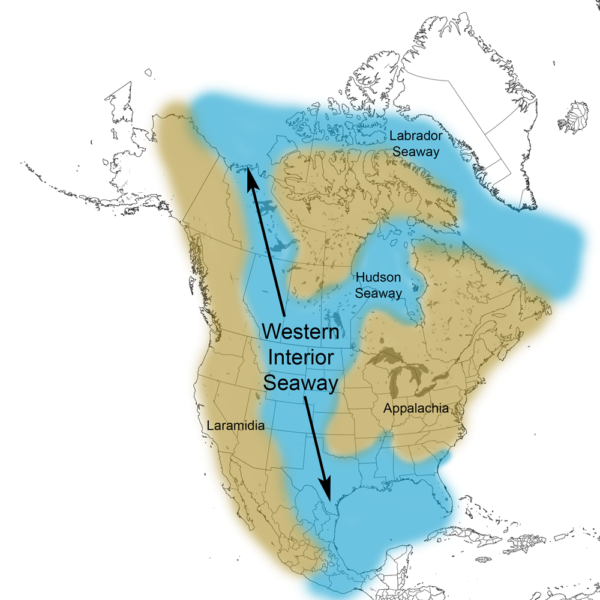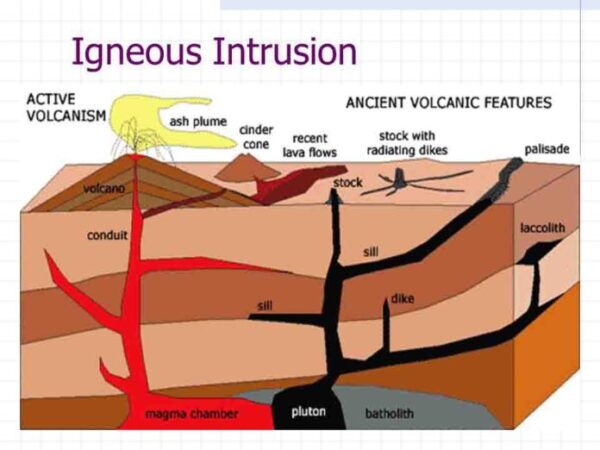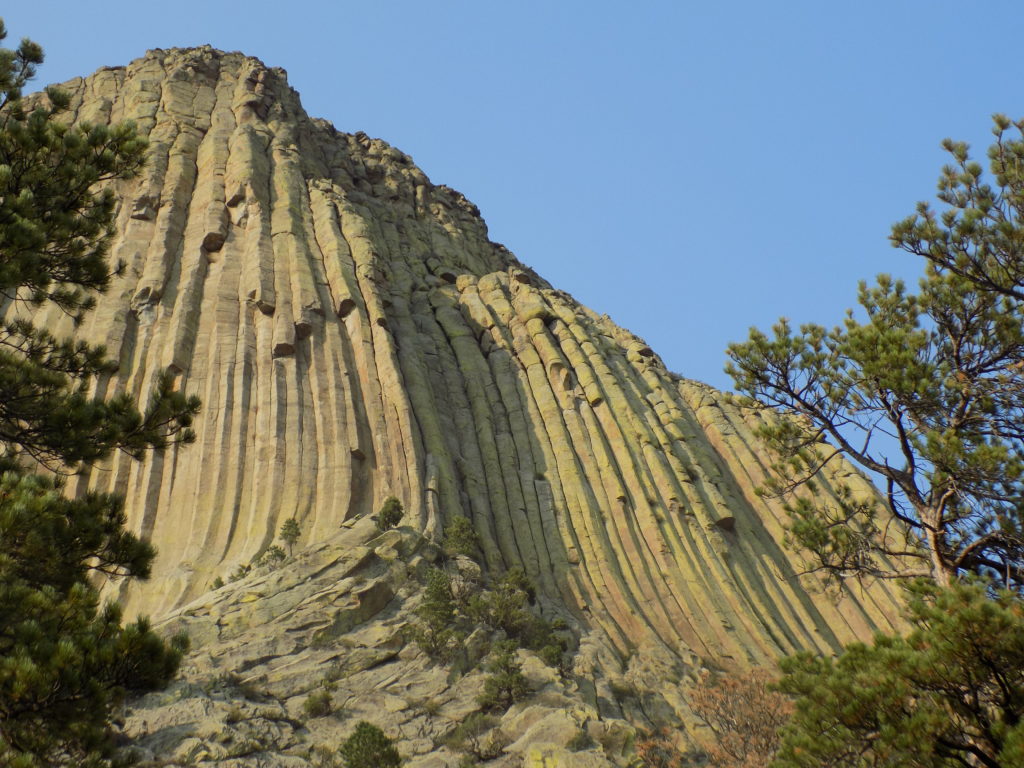What is Devils Tower?
Setting the Stage.
Most of the landscape surrounding Devils Tower is composed of sedimentary rocks. Even with no prior knowledge, if you’ve been reading this or my first recounting of my travels through the western U S, you should reflexively know that sedimentary rocks are broken or dissolved fragments of other rocks that are usually deposited by water and sometimes by wind. Several distinct layers of rock are visible (at least to geologists) in and around Devils Tower National Monument.
The oldest visible rocks were laid down in the Western Interior Seaway – the shallow inland sea we encountered in the discussion of the Canadian Rockies.

[Western Interior Seaway – from Cretaceous Atlas of Ancient Life.]
As you can see from the map, this body of water covered much of the central and western United States in the Triassic some 225 to 195 million years ago (M Y A). The Belle Fourche (pronounced Bell Foosh) River, called Šahíyela Wakpá in Lakota, springs from headwaters about 90 miles southwest of the tower and flows through the national monument depositing sediment of iron rich sandstone and siltstone interbedded with shale in a layer called the Spearfish Formation.
A thin band of white gypsum, called the Gypsum Springs formation deposited during the Jurassic Age (195-136 m y a) sits atop the Spearfish Formation. I note this because gypsum is commonly used in making drywall referred to in some parts of the country as Sheetrock. (Keep in mind that Sheetrock is actually a brand name so while all Sheetrock is drywall, not all drywall is Sheetrock.)
Throughout the Jurassic, as the Western Interior Seaway retreated and returned, it deposited gray-green shales in its deeper marine environments which were then interbedded with fine-grained sandstones, limestones, and sometimes thin beds of red mudstone. These rock layers, called the Stockade Beaver member, are part of the Sundance Formation.
A series of nearly vertical cliffs encircle the broader area of the Tower itself. These are comprised mainly of Hulett Sandstone which is also part of the Sundance Formation. This yellow, fine-grained sandstone was deposited on an ancient beach and is exceptionally resistant to weathering.
Between 70 and 35 M Y A, as the Laramide Orogeny was engaged in lifting the Rockies to the west of Devils Tower, it had some consequences to the east as well. Its movements began squeezing magma toward the earth’s surface. Because the magma was less dense than the surrounding rock and the surrounding structural zone, it allowed the magma to move relatively easily. Generally, as magma nears the surface, it collects in a large underground pool called a magma chamber. Once the magma forms a chamber one of three things can happen. It can remain in it until it cools and crystallizes forming igneous rock as it does so, it can fracture the surrounding rock, move upward and erupt as a volcano, or it can squeeze, ooze and seep into another magma chamber. Here begins the mystery of the Tower.
Forming the Tower: An Ongoing Debate.
Until recently, a rare point of consensus among geologists was that Devils Tower was formed by the intrusion (the forcible entry of magma into or between other rock formations) of igneous material. Unsurprisingly, scientists call this an igneous intrusion.

[Image from Geology Page.]
Beyond that, there’s no general consensus about how that process took place nor can they agree whether the magma reached the land surface or not. Numerous ideas have evolved since the official “discovery” of Devils Tower.
The notion of the Tower being an igneous intrusion was first put forth in the 19th century. Then in the early 20th century geologists proposed the idea that Devils Tower must be an eroded remnant of a laccolith. (A laccolith is a large, mushroom–shaped mass of igneous rock that intrudes between the layers of sedimentary rocks but doesn’t reach the surface. This produces a rounded bulge in the sedimentary layers above the intrusion.) This idea was quite popular in the early 1900s when numerous studies were done on laccoliths in the Southwest.
Other ideas have suggested that Devils Tower is a volcanic plug

[Image from Volcano Hotspot.]
or that it’s the neck of an extinct volcano. Although there is no evidence of volcanic activity – volcanic ash, lava flows, or volcanic debris – anywhere in the surrounding countryside, those proposing this view hold that such material may simply have eroded away.
A paper presented at the 2011 meeting of the American Geophysical Union asserted, “the geological evidence suggests that the Devils Tower is a remnant of an eroded lava lake that filled a broad phreatomagmatic volcano crater.” (A phreatomagmatic eruption involves both magma and water. These typically interact explosively, leading to concurrent ejection of steam and pyroclastic fragments.)
Still another explanation is that Devils Tower is a stock. A stock is a small intrusive body formed by magma that cooled underground and was later exposed by erosion. So, while there is overall agreement that Bear’s Lodge is an igneous intrusion, certain specifics regarding its creation and appearance currently remain unresolved.
The magma that formed Devils Tower cooled and crystallized into a rock type known as phonolite porphyry. It is a light to dark-gray or greenish-gray igneous rock with conspicuous crystals of white feldspar. Hot molten magma is less dense and occupies more volume than cool hardened rock. As the rock cooled, it contracted, forming hexagonal (and sometime 4-, 5- and 7-sided) columns separated by vertical cracks.
These columns are similar to those found at Devil’s Postpile National Monument in California but those at Devils Tower are much larger.
And Bears Lodge is big. It’s 867 feet from the base, which is a mile in circumference, to the summit which sits 5,112 feet above sea level. At the top, the Tower is comparable in size to an American football field. It’s about 60 yards wide and 100 yards long. It is not, as some seem to think, hollow.
Uncovering the Tower.
It’s likely that until erosion began its relentless work between five and ten million years ago, Devils Tower wasn’t visible above the overlying sedimentary rocks. But the forces of erosion, particularly that of water, began to wear away the soft sandstones and shales above and around the Tower. The much harder igneous rock of the Tower survived the onslaught of erosional forces and the gray columns of Devils Tower began to appear above the surrounding landscape.
As rain and snow continue to erode the sedimentary rocks surrounding the Tower’s base, and the Belle Fourche River carries away the debris, more of Devils Tower will be exposed. But at the same time, the Tower itself is slowly being eroded. Rocks are continually breaking off and falling from the steep walls. Rarely do entire columns fall, but on rare occasions, they do. The piles of rubble, broken columns, boulders, small rocks, and stones that lie at the base of the Tower (described as the boulder field), indicate that it was, at some time in the past, larger than it is today.
Now that I’ve put forth what the geologists have to say about the Tower, in the next (relatively short) posts, I’ll share some of the Native American legends about it because often those legends are more interesting and usually more entertaining than the science.

